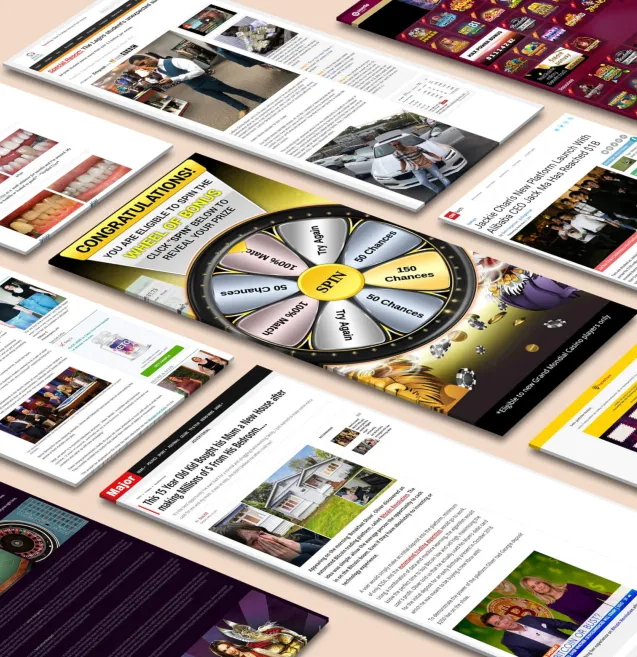
Our spy tools monitor millions of popup and pop-under from over 90+ countries and thousands of publishers.
Get StartedImagine this: A visitor lands on your website, browses through your products, adds items to their cart, but suddenly moves their cursor towards the exit button. This critical moment presents a golden opportunity to recover a potentially lost sale - enter exit-intent popups.
Exit-intent popups are smart website tools that detect when visitors are about to leave your site. These powerful conversion tools spring into action at precisely the right moment, displaying targeted messages, offers, or reminders that can transform abandoning visitors into loyal customers.
The impact of these popups on your business can be substantial:
A well-crafted exit-intent strategy doesn't just stop visitors from leaving - it creates meaningful interactions that boost engagement and drive conversions. By implementing these strategic popups, you can tap into a proven method for recovering lost sales and building lasting customer relationships.
However, it's important to note that not all pop-up ads are well-received. In fact, some can be quite annoying for users. To avoid this pitfall, consider implementing simple hacks to stop annoying pop-up ads which can significantly improve user experience on your site.
Moreover, if you're looking to expand your advertising strategy beyond just website pop-ups, learning the secrets of massively scalable pop advertising could provide valuable insights.
Exit-intent technology uses advanced algorithms to track user behavior, such as mouse movements and scrolling patterns. When certain triggers are detected, the system activates:
These signals indicate that a visitor is about to leave your site, prompting the display of targeted popup messages at critical moments.
There are different types of exit popups designed to target specific types of visitors who abandon their actions:
These popups provide incentives for users to complete their purchase by offering discounts or promotions. Examples include:
Lead magnets aim to capture visitors' contact information by offering valuable resources in exchange. Common lead magnets include:
When users add items to their cart but leave without completing the purchase, cart abandonment recovery popups come into play. These reminders can include:
One of the key advantages of exit-intent popups is the ability to personalize messages in real-time based on user data. This allows you to tailor your offers and incentives specifically to each visitor's preferences and behaviors. Some examples of user data that can be utilized for personalization include:
By leveraging this information, you can increase the relevance and effectiveness of your popup messages, making them more likely to resonate with your audience.
To ensure optimal engagement without overwhelming users with too many popups, smart exit-intent systems have the capability to adapt message timing and frequency based on various factors. This dynamic approach helps strike a balance between recovery attempts and user experience, ensuring that your popup strategy remains effective without becoming intrusive.
For instance, if a particular visitor has already seen multiple exit popups during their session, the system may choose not to display another one in order to avoid creating popup fatigue. Instead, it could focus on other recovery methods such as sending follow-up emails or retargeting ads after they leave your site.
By implementing these strategies and continuously testing different variations of your exit-intent popups, you can optimize their performance over time and achieve better results in terms of conversion rates and customer retention.
Exit-intent popups deliver impressive results when it comes to boosting conversion rates and customer retention. Research shows these strategic interventions can increase conversions by up to 53% when implemented correctly.
Let's look at the numbers:
These statistics translate into real business impact. A case study from digital retailer BrandCo showed a 46% increase in completed purchases after implementing exit-intent popups with personalized discount offers.
Exit-intent popups enhance user experience by:
The technology's success lies in its ability to engage users at critical decision points. By analyzing user behavior patterns, exit-intent popups can display targeted messages that resonate with specific customer segments. This personalization leads to higher engagement rates and improved customer satisfaction scores.
A/B testing data reveals that exit-intent popups perform best when they:
Personalization is the key to successful exit-intent popup campaigns. Your visitors expect tailored experiences, making generic popups less effective in today's digital landscape.
Creating targeted messages based on user behavior amplifies your popup's impact. A first-time visitor might respond well to a newsletter signup offer, while a returning customer could be enticed by a loyalty program invitation.
You can use dynamic content to create compelling scenarios. For example, display different offers based on cart values:
By integrating these elements, you create personalized experiences that resonate with your visitors. A jewelry store might show different popups to engagement ring browsers versus casual accessory shoppers. An electronics retailer could display technical specification downloads to professional buyers and warranty information to regular consumers.
The power of personalization extends to timing and context. Analyze your visitors' browsing patterns to determine optimal moments for popup displays. A visitor reading blog content might appreciate a related ebook offer, while someone browsing product pages could respond better to a limited-time discount.
Creating visually appealing exit-intent popups requires a careful balance between attractiveness and functionality. Your popup design directly affects user experience and conversion potential.
The ideal popup should cover 30-40% of the screen on desktop devices and 60-70% on mobile. Position your popup in the center of the screen to maintain visual balance and capture attention naturally.
Run A/B tests on these design elements:
Your popup design should reflect your brand's visual identity while keeping things simple. Consider using subtle animations to enhance engagement without causing distraction. Mobile responsiveness is crucial - ensure your design adapts seamlessly across all device sizes.
A/B testing is a crucial part of optimizing your exit-intent popup strategy. Here's how to make the most of your conversion potential:
Track key metrics like conversion rate, bounce rate, and engagement time to refine your approach. Regularly analyzing these metrics helps identify patterns and opportunities for improvement. Remember to keep your testing periods long enough to gather statistically significant data - typically 2-4 weeks per test variation.
Building trust with your website visitors requires a delicate balance between marketing goals and user experience. Exit-intent popups must respect user autonomy and privacy while delivering value.
Key ethical practices include:
Your popup design should align with ethical marketing principles:
Privacy-focused implementation:
The most effective exit-intent popups create genuine connections with users through valuable offers and respectful engagement. This approach builds lasting relationships while maintaining high ethical standards in your marketing strategy.
Exit-intent popups are a powerful tool for optimizing conversions. When designed with the user in mind and used ethically, these popups can turn abandoning visitors into valuable leads and customers.
To succeed with exit-intent popups, focus on:
Your exit-intent strategy should evolve based on data insights and user feedback. By following the best practices in this guide, you can create compelling popups that grab attention and drive conversions. Implement these strategies now to fully utilize exit-intent technology and see your conversion rates rise.
Receive top converting landing pages in your inbox every week from us.
None
Q4’s advertising landscape is crowded, but smart pop ad strategies can help your brand stand out. Learn how to capture attention, reduce bounce rates, and drive conversions even amid the seasonal overload. Explore targeting techniques, creative best practices, and timing tactics that deliver real results. Ideal for advertisers looking to make the most of Q4’s busiest—and most competitive—season.
David Kim
7 minDec 3, 2025
In-Depth
After the holiday rush, analyzing ad performance is key to improving future results. Discover how AI can uncover hidden insights, identify optimization opportunities, and refine your targeting for better ROI. Learn how data-driven automation helps sustain momentum even after peak season. Ideal for marketers seeking smarter ways to enhance post-holiday campaign performance.
Samantha Reed
7 minNov 28, 2025
Guide
This blog dives into the power of cross-screen pop advertising and how it helps brands stay visible across multiple devices. It discusses key strategies for creating cohesive campaigns that engage users whether they’re on desktop, mobile, or tablet. Readers will discover optimization techniques, targeting tips, and creative best practices to improve performance. Ideal for advertisers looking to boost reach and conversions through a unified pop ad approach.
Elena Morales
7 minNov 16, 2025




